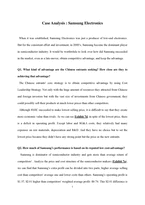Q2. How much of Samsung’s performance is based on its reputed low cost-advantage?
Q3. Can Samsung’s low-cost advantage withstand the Chinese threat on costs?
Q4. Does anyone think the numbers mask the fact that Samsung’s differentiation advantage is more important or easier to grow and sustain, or both?
Q5. If Samsung is both low-cost and differentiated, how does it do both?
Q6. Why can’t more firms in other industries do the same?
Conclusion
Exhibits
When it was established, Samsung Electronics was just a producer of low-end electronics. But for the consistent effort and investment, in 2000’s, Samsung become the dominant player in semiconductor industry. It would be worthwhile to look over how did Samsung succeeded in the market, even as a late-mover, obtain competitive advantage, and keep the advantage.
Q1. What kind of advantage are the Chinese entrants seeking? How close are they to achieving that advantage?
The Chinese entrants’ core strategy is to obtain competitive advantage by using Cost Leadership Strategy. Not only with the huge amount of resources they attracted from Chinese and foreign investors but with the vast size of investments from Chinese government, they could possibly sell their products at much lower prices than other competitors









 분야
분야


